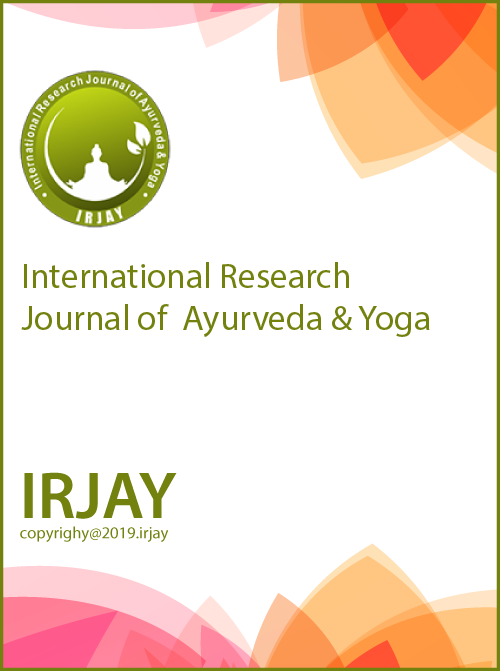A Critical Review of Ojas: An Ayurvedic Concept of Immunity
DOI:
https://doi.org/10.48165/IRJAY.2025.80108Keywords:
Ayurveda, Health disorders, Immunity, Oja depletion, Ojas, Ojas formation, Rasayana, Strength, Vajikarana, VitalityAbstract
Ojas is a concept in traditional Ayurvedic medicine that represents the vital essence or energy within the body, essential for maintaining life, health, and vitality. It is considered the physical and spiritual foundation of well-being, influencing immunity, longevity, and the body’s ability to adapt to stress. In Ayurveda, Ojas is categorized into two main types: Para Ojas (primary Ojas), Para Ojas, which is stored in the heart and governs overall health, and Apara
Ojas (secondary Ojas), which circulates throughout the body and supports bodily functions. Ojas is believed to be the product of proper digestion and assimilation of food and experiences, serving as the byproduct of a balanced and harmonious life. A deficiency in Ojas can lead to fatigue, weakened immunity, and a range of physical and mental health issues, while an excess of Ojas can result in overconfidence or imbalance. Practices such as proper nutrition, meditation, physical activity, and good sleep hygiene are all integral to maintaining and cultivating healthy Ojas. Recent research into the concept of Ojas suggests potential connections with modern understandings of immunity and vitality, although much of the original Ayurvedic framework remains rooted in traditional knowledge. As an essential life force, Ojas continues to play a significant role in holistic health practices, integrating mind, body, and spirit. This research underscores the essential role of Ojas in Ayurvedic health systems and offers insights into the practices that promote its balance, contributing to overall vitality and disease resistance.
Downloads
References
Acharya YT, editor. Charak samhita of agnivesha, sutra sthana. Ch. 29, Ver. 3. Varanasi: Chaukhambha Orientalia; 2006. p. 181. 2. Aacharya VJ. Agnivesha, charaka, dridhabala, charaka samhita, chikitsasthhana grahnidosh chikitsatm, 3-5/15, chaukhamba Sanskrit sansthan, 9-10/30. Varanasi, India: Chaukhambha Orientalia; 2016. p. 512.
Acharya YT, editor. Charak samhita of agnivesha, sutra sthana, Ch. 30, Ver. 7. Varanasi: Chaukhambha Orientalia; 2006. p. 184. 4. Acharya YT, editor. Sushruta samhita of sushruta, sutra sthana. 9th ed., Ch. 15, Ver. 19. Varanasi: Chaukhamba Orientalia; 2007. p. 71. 5. Deole YS, Shilwant AA. Concept of Ojas. Available from: https:// www.carakasamhitaonline.co m/index.php/ojas#cite_note-3 [Last accessed on 2024 Aug 12].
Acharya YT, editor. Sushruta samhita of sushruta, sutra sthana. 9th ed., Ch. 15, Ver. 24. Varanasi: Chaukhamba Orientalia, 2007. p. 72.
Available from: https://www.carakasamhitaonline.com/index. php?title=ojas [Last accessed on 2024 Sep 10].
Acharya YT, editor. Chakrapanidatta commentary on charaka samhita of agnivesha, sutra sthana. Ch. 28, Ver. 7. Varanasi: Chaukhambha Orientalia; 2006. p. 178.
Acharya YT, editor. Charak samhita of agnivesha, sutra sthana, Ch. 15, Ver. 3. Varanasi: Chaukhambha Orientalia; 2006. p. 512. 10. Acharya YT, editor. Charak samhita of agnivesha, sutra sthana. Ch. 11, Ver. 36. Varanasi: Chaukhambha Orientalia; 2006. p. 74. 11. Acharya YT, editor. Charak samhita of agnivesha, sutra sthana, Ch. 24, Ver. 31. Varanasi: Chaukhambha Orientalia; 2006. p. 584. 12. Acharya YT, editor. Charak samhita of agnivesha, sutra sthana. Ch. 17, Ver. 74. Varanasi: Chaukhambha Orientalia; 2006. p. 103. 13. Shastri KA, editor. Dhanwantari sushruta, sushrutasamhita edited with hindi ayurveda tattva sandeepika Hindi commentary, sutrarsthana. Ch. 15, Ver. 20. Varanasi: Chaukhambha Sanskrit Sansthan; 2009. 14. Dwarikanath C. Introduction to kayachikitsa. 3rd ed. Varanasi: Chaukhambha Orientalia; 1996. p. 267.

